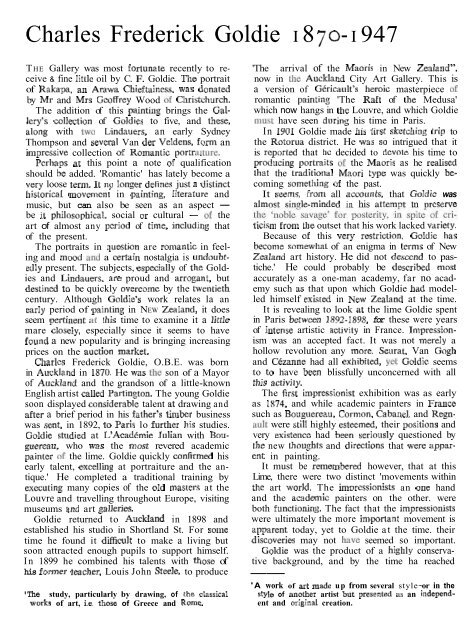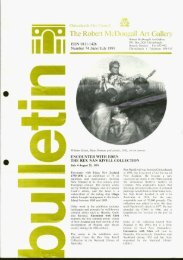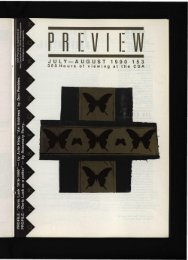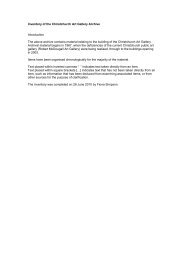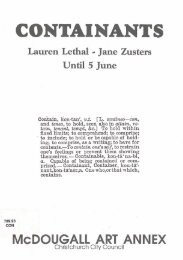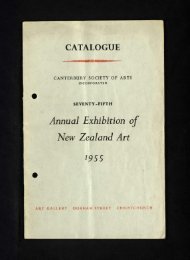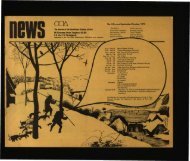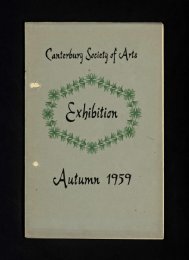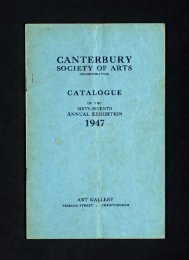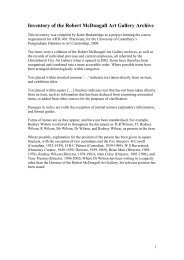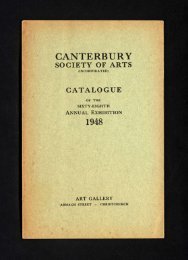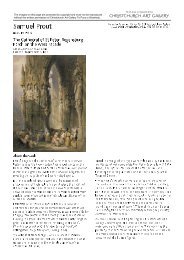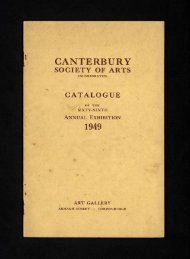Download (1.9 MB) - Christchurch Art Gallery
Download (1.9 MB) - Christchurch Art Gallery
Download (1.9 MB) - Christchurch Art Gallery
You also want an ePaper? Increase the reach of your titles
YUMPU automatically turns print PDFs into web optimized ePapers that Google loves.
Charles Frederick Goldie I 8 70- I 947<br />
THE <strong>Gallery</strong> was most forlunate recently to re-<br />
ceive & fine iilllc oil by C. F. Goldie. The portrait<br />
of Rakapa, an Arawa Chieftilincss, was donated<br />
by Mr and Mrs Gmffrey Wood or Christchhurch.<br />
The addition of this pinting brings the Gal-<br />
Icry's calieclion of Goldics to five, and these,<br />
along with two Lindauers, an early Sydney<br />
Thompson and sevcnl Van der Veldens, foim an<br />
impicssive collection of Romilntic portr d~lurc. .<br />
Pcrhaps at this point a note ol qualification<br />
should bc added. 'Romantic' has lately become a<br />
veiy loose tsrnm. 11 np ionser delines just u dislinct<br />
hislorical imovcmcnl in painling, iiterature and<br />
music, but can also be seen as an aspect -<br />
be il philosophicai. social or cultural - of the<br />
art of almost any pcriod of lime, including that<br />
of the present.<br />
The portraits in qualion are romanlic in feel-<br />
ing and mmxi and a certain nostalgia is ondoubt-<br />
edly present. The subjects, espcciully of Lhe Gold-<br />
ies and Lindauers. are proud and airoganl, but<br />
destincd to be quickly overcomc by the lwcnlieth<br />
century. Although Goldie's work relates la an<br />
early period of painling in NEW Zaiund, it does<br />
seem pcrtii~ent at lhis time to examine it a littie<br />
mare closely, especially since it seems to have<br />
found a new popularity and is bringing increasing<br />
prices on the auclion markel.<br />
Charlcs Frederick Goldie, O.B.E. was born<br />
in Aockland in 1870 He was tho son of a Mayor<br />
of Auilhlvnd and the grandson of a little-known<br />
English artist called Parlington. The young Goldie<br />
soon displayed considerdble talent a1 drawing and<br />
after a brief period in his father's limber business<br />
was sent, in 1892, to Paris lo furthei llis studies.<br />
Goidic shtdied at L'AeadCmie Julian with Bou-<br />
guerau, who wi?s the most revered academic<br />
paintcr or the lime. Goldie quickly confirmed his<br />
early talent, excelling at portraiture and the an-<br />
tique.' He completed a traditional training by<br />
encculing many copies of the old maslcrs at the<br />
Louvre and travelling throughout Europe, visiting<br />
museums and art gallerias.<br />
Goldie returned to Auckland in 1898 and<br />
established his studio in Shortland St. For some<br />
time he found it ditlimlt to make a living but<br />
soon attracted enough pupils to support himself.<br />
In 1899 he combined his talents with those of<br />
his former teacher, Louis John Steele, to produce<br />
'The study, particularly by drawing, of rhe clasrical<br />
works of art, ie. those of Greece and Romc.<br />
'The arrival of the Maoris in New Zealand':<br />
now in the Auckland City <strong>Art</strong> <strong>Gallery</strong>. This is<br />
a version of Gericault's haroic masterpiece of<br />
romantic pvinting 'The Raft of the Medusa'<br />
which now hangs in lhe Louvre, and which Goldie<br />
'n~usl have seen duriw his time in Paris.<br />
In 1901 Goldie made iiis first sketchimg lrip to<br />
the Rolorua district. He was so intrigued that it<br />
is icported that hc decided to devnle his time to<br />
prmlucing porlmits of the Maoris as he realised<br />
lhal the Lrvditioival Maori type was quickly bccoming<br />
somelhing of the past.<br />
It sezrnc, from all ucmunls, that Goldic was<br />
almmi sinslemindad in his attemot tn nrcserve<br />
ticism from the outset that his work lacked vaiicty.<br />
Because of this veiy restriotion. Goidic has<br />
became somewhnl of an enigma in tcims of New<br />
Zzaivnd art history. He did not desccnd to pas-<br />
tiche.' He could probably be described ,most<br />
accurately as a one-man academy, far no acad-<br />
emy such us that upon which Goldie had model-<br />
led himself enisred in Now Zealand at the time.<br />
It is revealing to look at the lime Goldie spent<br />
in Paris between 1892.1898, for these were years<br />
of intense artistic activily in France. Tnipiession-<br />
ism was an accepted fact. It was not merely a<br />
hollow revolution any more. Seurat, Van Gogh<br />
and Cbranne had all exhibiled, yet Goldic seems<br />
to to have been blissfully unconcerned with all<br />
this activiry.<br />
The fiw impresrionist exhibition was as early<br />
as 1x74, and while academic painters in France<br />
such as Bouguereau, Carmon. Caband. and Regn-<br />
auk were slili highly eslemed, their posilions and<br />
very existancc had ,been rcriously questioned by<br />
the new ihoughts and direclions that were appai-<br />
ent in painting.<br />
It must be remembered however, that at this<br />
Lime, there were two distinct 'movements within<br />
thc art world. The imorcssionists an one hand<br />
and the academic painters on the other. were<br />
both functionirg The fact that the impressionisls<br />
were ultimately the more impoflant movement is<br />
Bpparent today, yet to Goldie at the time. their<br />
discweria may not haw seemed so important.<br />
Coldie was the product of a h'iglily conserva-<br />
tive background, and by the time ha reached<br />
--<br />
'A work of ilit mado up from several style~ or in the<br />
style of another artist but presented a3 an independ-<br />
ent and original creation.


